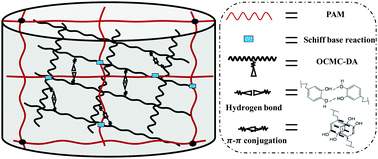Mussel-inspired hybrid network hydrogel for continuous adhesion in water†
Abstract
The mussel-inspired catechol-based strategy has been widely used in the development of adhesives. However, the properties of the obtained adhesives were still severely limited in a humid environment, particularly in water. In this study, a facile and versatile approach was proposed to prepare an underwater adhesion hydrogel. First, dopamine (DA) was grafted on oxidized carboxymethylcellulose (OCMC) to obtain dopamine-grafted oxidized carboxymethylcellulose (OCMC-DA). Second, the acrylamide (AM) monomer was conjugated with OCMC-DA by a Schiff base reaction, and then polymerized to form an OCMC-DA/PAM hydrogel. The properties of the resulting hydrogel have been fully characterized. The underwater adhesion strength of the hydrogel can reach as high as 86.3 ± 7.2 kPa and reduced to 43 ± 3.4 kPa after being immersed in water for 9 days. More remarkably, we found that the maximal adhesion strength was shown when the G′ and G′′ of the hydrogel were very close. Moreover, we demonstrated the mechanical properties of our fabricated hydrogel by compressive tests and rheological analysis. The adhesive hydrogel also exhibits excellent biocompatibility.



 Please wait while we load your content...
Please wait while we load your content...